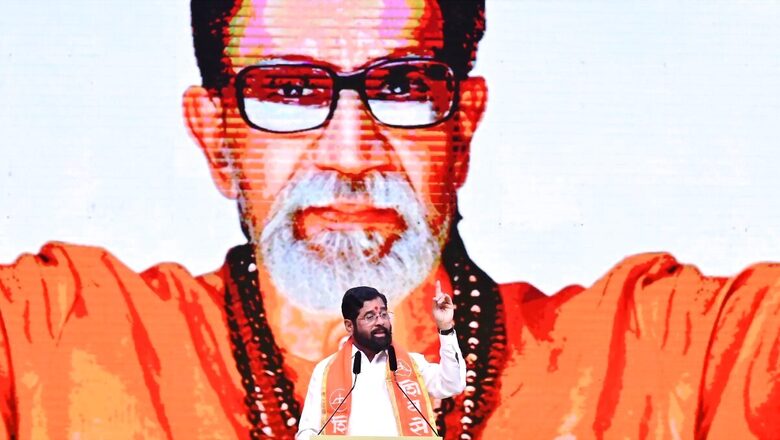
views
The regional film industry has produced several films that delve into political and socio- economic narratives, each leaving an indelible impact on society. As political dynamics shift, these cinematic works become more than just entertainment; they act as instruments for image building and political manoeuvring. Many political leaders have used films to reshape their public personas, turning criticism into admiration. One such recent example is DharmaVeer-2, a film that has been making waves in Maharashtra politics by focusing on the legacy of the late Shiv Sena leader Anand Dighe and current chief minister Eknath Shinde.
Dighe was a charismatic figure in the Shiv Sena, particularly in Thane district, where he played a crucial role in expanding the party’s influence beyond its Mumbai base. He was instrumental in solidifying the Sena’s presence in Thane and Palghar districts, transforming the party from a primarily Mumbai-centric political force into a regional powerhouse.
The first Dharmaveer movie recounted this rise, showing how Shinde, under Dighe’s leadership, became a key figure in the Sena. The film left audiences with an emotional and dramatic cliff-hanger: the sudden and mysterious death of Dighe following a reportedly successful surgery. The unresolved narrative set the stage for the second instalment, DharmaVeer-2, which explores the party’s political evolution following Dighe’s demise.
The sequel shifts focus to Uddhav Thackeray’s tenure as Maharashtra’s chief minister and the controversies that followed. The film depicts Thackeray’s controversial decision to form the Maha Vikas Aghadi (MVA) government — an alliance between the Shiv Sena, Congress, and Nationalist Congress Party (NCP) — after breaking ties with the Bharatiya Janata Party (BJP). This alliance, which aimed to secure power in the state, was seen by many as a betrayal of the core principles of ‘Hindutva’— the ideology that had been central to the Shiv Sena’s identity since its inception by Balasaheb Thackeray.
Through a series of dramatic scenes, DharmaVeer-2 suggests that Uddhav Thackeray distanced himself not only from his father’s ideology but also from key leaders within his party. Allegations of neglect and unavailability during critical moments are highlighted in the film, along with the suggestion that Congress’s influence led Thackeray to forsake Shiv Sena’s traditional policies in favour of those aligned with Congress’s agenda. The film indirectly criticises the Congress while portraying Thackeray as a leader who has lost touch with both his party’s roots and his own core constituency. Interestingly, unlike the first part, neither has Thackery’s name been taken in the film, nor his character shown but his former colleagues are seen criticising his policies and decisions which were not in line with ‘Hindutva’ which Shinde is trying to preach.
Shinde’s rebellion against Thackeray’s leadership forms the crux of the second film. The filmmakers highlight how Shinde and other loyal Shiv Sena members, staunch followers of Balasaheb Thackeray’s Hindutva ideology, felt marginalised and suffocated within the MVA. According to the film, these leaders could not reconcile their beliefs with Thackeray’s newfound political alignments, particularly his alliance with the Congress.
The backdrop of the narrative is the Sena’s poor performance in the recent Lok Sabha elections, where the Mahayuti alliance, led by Shinde, won just 17 seats. Despite Shinde’s leadership, the alliance struggled to gain traction, and NCP leader Ajit Pawar was blamed for the poor transfer of votes between parties. However, the election results were also seen as a reflection of public dissatisfaction with Shinde’s governance and the political drama that unfolded two years prior when he led a rebellion against Thackeray.
Shinde, who took with him more than 40 MLAs and a substantial number of MPs, eventually secured the party name, symbol, and power in the state government. Despite these achievements, he is yet to fully win over the electorate and is struggling to shake off accusations of betrayal.
DharmaVeer-2 paints Shinde’s defection in a positive light, presenting it as a principled stand rather than an opportunistic move. The timing of the film’s release, ahead of crucial state assembly elections, has sparked discussions about its role in shaping public opinion. Shinde’s detractors, especially those loyal to Uddhav Thackeray, have long accused him of betraying Balasaheb Thackeray’s legacy for power and financial gain. The film seeks to counter this narrative, portraying Shinde and his fellow defectors as individuals who were forced to rebel due to the former chief minister’s compromises on Hindutva.
While the film is critical of Congress, it portrays NCP leader Sharad Pawar and Maharashtra Navnirman Sena (MNS) chief Raj Thackeray in a positive light. Pawar is praised for his ability to connect with his party workers and his support for artists, a contrast to Uddhav Thackeray’s alleged detachment. Raj Thackeray is depicted as the rightful heir to Balasaheb Thackeray’s legacy, suggesting that had he not parted ways with the Shiv Sena to form his own party, he could have carried the party forward. These positive depictions of Pawar and Raj Thackeray have led to speculation about potential alliances between Shinde and the two leaders, further complicating the political landscape as the assembly elections approach.
As DharmaVeer-2 draws to a close, it depicts Shinde and his colleagues making the pivotal decision to travel to Surat, with Shinde declaring his unwavering commitment to Hindutva. This sets the stage for the upcoming elections, which will serve as a critical test for both factions of the Shiv Sena. The question remains whether the film will successfully reshape public opinion in Shinde’s favour. Will it help Shinde’s faction of the Shiv Sena gain the upper hand in the election, or will Uddhav Thackeray’s faction retain the loyalty of traditional Shiv Sainiks?
For Shinde, this election is more than a battle for political power — it is a fight to clear his name and prove his allegiance to Balasaheb Thackeray’s ideology. For Uddhav Thackeray, the stakes are equally high. He must convince voters that despite forming the MVA, he has remained true to Hindutva. The outcome of this electoral contest will not only determine who controls the Shiv Sena but will also shape the future of Maharashtra politics.



















Comments
0 comment